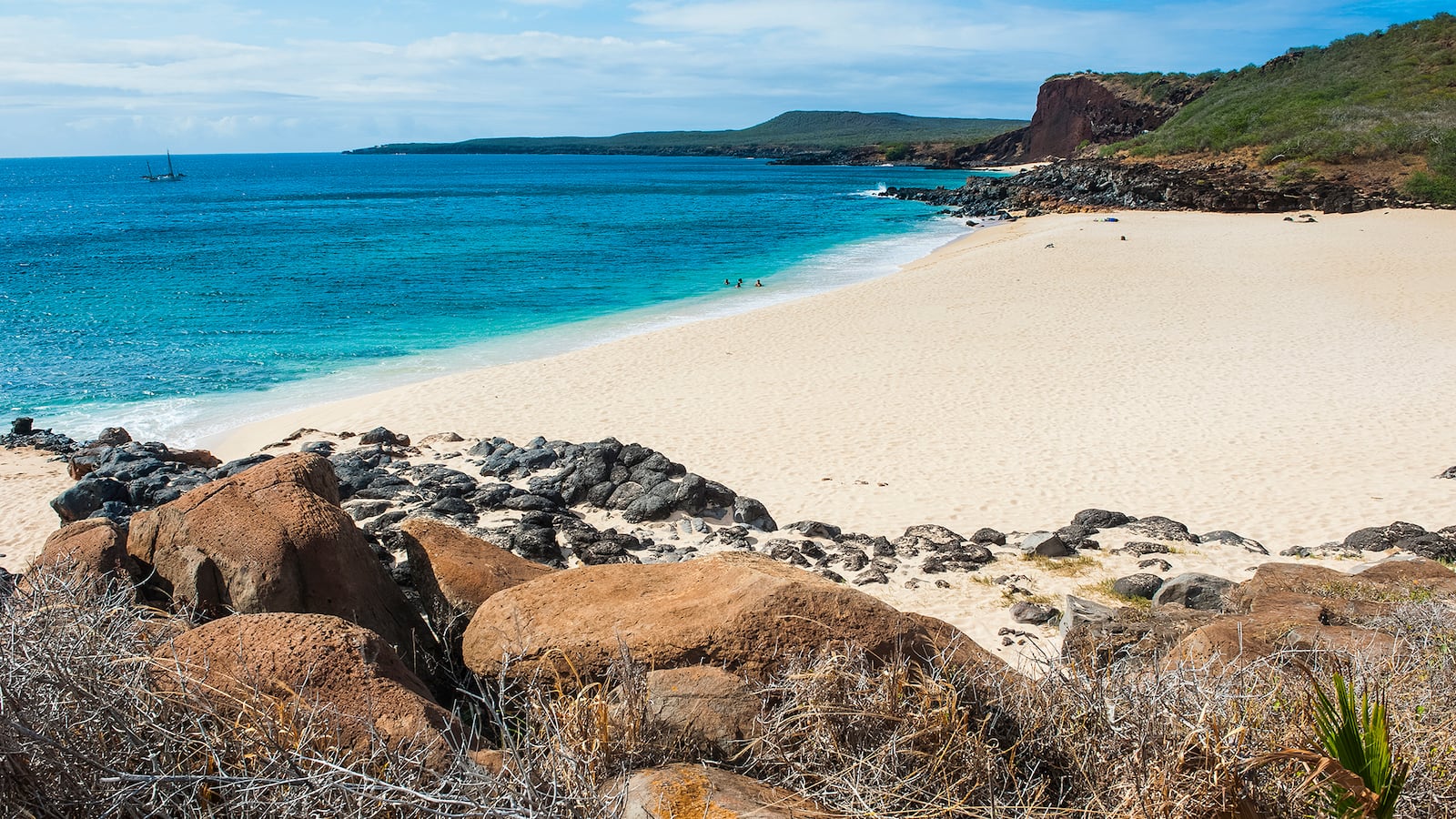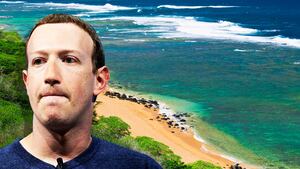One Saturday in May, a group of Molokai, Hawaii, residents met at the fence to a private ranch, cut the lock, and walked inside. Carrying flags and singing native songs, the 100-plus residents marched about a mile to the beach, where one knelt and performed a ritual blessing. Then they sat for several hours, protesting the private company that had blocked off access to what the locals claim is a historic site—and theirs by law.
“We’re walking for our young people so they can go hunting and fishing here,” local activist Walter Ritte told the crowd, according to the Molokai Dispatch. “It is a constant battle to keep your rights alive.”
The protesters’ intended audience was Guoco Capital Group, a Hong Kong-based investment firm that over the course of 15 years gained control of nearly a third of the 261-square-mile island, attempted to develop it, and then abandoned it. The 53,000-acre tract known as Molokai Ranch has sat largely unused for six years, falling into greater and greater disrepair.
While the islanders were marching on the blocked beach, they were also protesting against the decades-long foreign rule of their island, and in support of a novel idea to regain control: buying the $260 million property back for themselves.

Kawela River protesters stand against the Molokai Ranch development.
Photo Illustration by Thomas Lev/Photo Illustration by Thomas Levinson/The Daily Beast/Getty/Wikimedia CommonsMolokai (pop: 7,500) is one of the least developed islands in Hawaii. More than 60 percent of the residents are of native Hawaiian ancestry, and more than a third rely on subsistence hunting and gathering to support themselves, according to the Molokai Community Service Council. There are no freeways, no stoplights, no fast food chains or high rises. The middle and high schools share a campus.
“It really is the last Hawaiian island,” Karen Holt, executive director of the council, told The Daily Beast. “Everything else is paved over.”
That is not by accident. The land where the ranch sits—on the dry, western side of the island—has served as a second home for Hawaiian royalty, a sugar cane plantation, a cattle ranch, and a pineapple farm. But one thing the locals have always been against is developing it for tourism.
In the 1970s, when the owner—then a Hawaiian pineapple magnate named Charles Cooke—proposed building a 30,000-resident suburb for Honolulu commuters, the locals protested so fiercely the project was dropped. In the 1980s, after a New Zealand Investment company, Brierley Investments, purchased the land, community demonstrations shut down the proposed construction of two hotels, 200 condominiums, a golf course, a clubhouse, and a timeshare development. In 1996, when the ranch began diverting more water to its properties, someone destroyed five miles of pipeline.
“We saw what tourism has done to the other islands,” said Ritte, the activist who led last month’s march. “It's just all overcrowded… They’re loving us to death.”

A Molokai protest march to Kawakiu beach in the 1970s. (Courtesy Walter Ritte)
Courtesy Walter RitteStill, by the time the Guoco Group took over in 2003 as part of its acquisition of Brierly, a few scattered developments had made their way through. The ranch boasted a high-end lodge with a pool, plus a movie theater, a restaurant, a golf course, and a general store. It also employed about 100 islanders—a significant source of income for the tiny local economy.
In 2007, the group proposed expanding the development with a 200-lot luxury subdivision on the beaches of Laau Point on the westernmost peninsula—a plan that divided the populace. Ranch employees supported it, fearing the developers would fire them if they did not get their way, according to Maui County Councilmember Keani Rawlins-Fernandez. But many maintained fierce opposition to any development. “There are some family members who haven't talked since,” Rawlins-Fernandez said.
“This was, from my perspective, the most devastating thing that [the Guoco Group] did to our island,” she added. “They divided communities and families. And they did not care.”
In the end the state Land Use Commission rejected the building permits, making the new construction impossible. The Guoco Group, recognizing defeat, shuttered operations on the island, closing the lodge, the restaurant, the general store, and the island’s only movie theater and filling in the pool with sand. They laid off some 100 ranch workers, sending the Molokai unemployment rate skyrocketing from 6.2 percent in 2007 to 13.7 percent in 2009. They even threatened to stop running their water and sewage utilities before a judge stepped in.
Finally, in 2017, the group officially put the land up for sale, listing it for $260 million with the luxury real-estate firm Sotheby’s. At the time, the group said it hoped to “identify a new owner with a new vision for Molokai Ranch.”
No such owner emerged. Despite reports of interest from several wealthy buyers—Mark Zuckerberg among them—the Molokai Ranch property has remained on the market for more than six years—virtually untended, according to locals. Roads go unrepaired, buildings sit rotting and unused. The ocean pools where locals used to fish are filled with sediment from unchecked erosion. Last year, during a particularly bad drought, cattle started wandering onto the beaches in search of water and dying, Rawlins-Fernandez said. No one arrived to clean up the carcasses.
“[The owners] don’t really care because they don’t live here and we’ve never met them,” Ritte said. “All we know is they’re mad because we wouldn’t give them our beaches.”
“They’re like an absentee landowner,” he added. “They’re like a shadow that nobody knows.”

Walter Ritte and Maui County Councilmember Keani Rawlins-Fernandez.
Courtesy Walter RitteThe idea of buying back the land came from an unlikely place: a small island off the coast of Scotland. In 1997, residents of the Isle of Eigg formed a land trust to buy their island back from its owner, British businessman Keith Schellenberg, following allegations of mismanagement. Around the same time, the Molokai residents were fighting with the ranch owners over yet another proposed development and strategizing how to have more control over the property. Karen Holt, the community service council director, said a friend sent her an article about Eigg and asked: “Why don’t you buy it?’”
That set off a nearly three-decade, painstaking struggle to regain local control.. As early as 1998, Molokai residents proposed the creation of a community land trust on their application to be an “enterprise zone”—a Clinton-era initiative that awarded grants to rural areas with plans for community revitalization. The land trust would be “a means by which the Moloka‘i community might truly become ‘empowered,’” they wrote, “because ownership of the island’s resources is the community’s surest guarantee that its own plans will be honored and implemented.” The island won the grant.
But winning back the island wasn’t as easy. To start with, $260 million is a steep asking price for an island of less than 8,000 people, about a third of whom rely on food stamps, according to the Honolulu Civil Beat. A crowdfunding attempt to raise the money in the early 2000s fell drastically short of its goal. Holt said offers by at least two other entities that promised to work with the islanders—including a wind energy company that wanted to put up turbines—were rejected by the Guoco Group. Two attempts by local lawmakers to exercise eminent domain and take the land back by force failed in the state legislature.
In recent years, however, the buyback campaign has been reinvigorated—in part because of a new generation of activists. One of them, Momi Afelin, is a grad student at Harvard who helps run a nonprofit called Sustainable Molokai. The group started advertising community meetings early last year; the first one attracted more than 100 people on Zoom.
The meeting revealed how difficult the path forward would be. Basic questions like “What is community ownership?” and “Where would we get the money?” went unanswered, tabled for future working group sessions. But there was no shortage of passion. At one point, a local whom Afelin referred to as “Uncle Jimmy” launched into a two-minute-long expression of gratitude for the organizers. “I know that we are here for one thing: We care for our Molokai,” he said. “The only way we can make this thing right is to come together as a community and put love in that land.”
Not everyone is sold on the buyback campaign. The ranch still employs a few dozen employees for upkeep, many of whom support the current owners. Others believe caring for the land is an uphill battle: Nelson Rapanot, a hunting outfitter, told the Honolulu Civil Beat last year that he believes the water shortage issues on the island are too great for a the locals to overcome alone. “It’s good to dream, but sometimes you’ve got to take a look at reality,” he said.
Still, councilwoman Rawlins-Fernandez said there has also been an uptick in outside interest. The group is talking with Kamehameha Schools, an investment management group that seeks to empower Hawaiian communities, and with the NDN Collective, a group supporting American indigenous communities. Ritte said the idea is gaining traction with the state government, and he has spoken with the Office of Hawaiian Affairs and Department of Hawaiian Homelands about the efforts. The mayor of Maui expressed his support for the project, telling the Civil Beat: “I stand ready to do what I can to help.”
The group is brainstorming creative ways to use the land for profit while still respecting its heritage. Rawlins-Fernandez said one option is offering carbon-offset credits in exchange for reforestation of the western side. Another developer suggested using the land to grow flowers to be used for biofuel, though an official offer never materialized. “We’ve been learning very quickly about how to create revenue models so that we can get interested parties,” the councilmember said.
The process is slow-moving, but the organizers say this is by design: They see the effort not as a short-term solution, but as part of a long-term movement for native Hawaiian rights.
“We’re hoping it will also pave the way and inspire our ohana on their other islands to pursue their [land]-back initiatives as well,” Rawlins-Fernandez said. “When we are successful in this model and how we do it, we're hoping the other islands will be able to follow our lead.”
In the meantime, the locals are working on winning smaller battles. In 2019, with the help of attorneys from EarthJustice, they approached the state Commission on Water Resource Management about restoring streams that were being diverted to the ranch. After receiving more than 100 pieces of testimony, the commission ordered the ranch to return the streams to their natural state last year.
The ranch owners resisted the beachfront protest in May, saying beach access had been restricted for safety reasons during a private hunt and telling locals they should schedule their visits to the property in advance. Still, they agreed to remove the locks from the gate while it assessed the legality of the situation.
“We’re doing all of these fights against them to try and figure out how to lower the price,” Ritte said.
“And I think we really got their attention,” he added with a smile.





